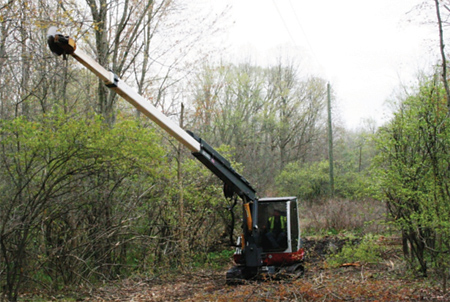When it comes to clearing the strips of land along utility lines, or the rights-of-way, many contractors have struggled to find an efficient method of trimming trees. For open areas, manufacturers have developed large-scale mechanical trimmers equipped with saw blades mounted on long booms. But for distribution lines in metropolitan areas and other confined spaces, contractors are caught in a tight spot — literally. Most resort to using chain saws and bucket trucks, slowly working their way down the line. However, for Kappen Tree Service this approach simply wouldn’t work.
As with many utilities on Kappen’s client list, part of the DTE Energy ongoing preventive maintenance program, is to visit each community in their service area, on average, every four to five years to clear trees away from pole-to-pole power lines. The utility contracts all of their line clearance work to professional tree-trimming services who follow accepted industry standards for line clearance, including directional pruning.
Detroit Edison generates, transmits, and distributes electricity to 2.1 million customers in southeastern Michigan. This makes it the largest electric utility in Michigan and one of the largest in the nation.
Based in Cass City, Michigan, Kappen Tree Service has been clearing rights-of-way for 20 years. Today, it services between 4,000 and 5,000 miles each year, depending on budgets. Kappen holds contracts with multiple electric utilities for doing work along a variety of transmission, sub-transmission and distribution lines.
Much of the contractor’s work started in the “thumb” of Michigan, where the landscape mainly consists of farmland and wood lots. Here it was easy for crews to get in and out with the seven large-scale mechanical trimmers in their fleet. However, Kappen eventually started getting distribution contracts farther south into the metropolitan Detroit area, where heavier traffic and smaller working areas limited the use of large equipment. “In the Detroit area, you can’t just drive down the road like you can in the northern part of the state,” said Warren Kappen, part owner of Kappen Tree Service.
As Kappen’s work started to shift south, he began looking for a more efficient alternative to trimming trees with chain saws and bucket trucks. “We probably have 100 bucket trucks, but those guys have to raise the machine, trim the branch with a chainsaw, come back down, and move the truck ahead to the next tree,” he said. Kappen also wanted something that could maneuver better than his bucket trucks. “They work in some of the small areas, but they’re just so clumsy.”
Eventually, Kappen discovered a new breed of equipment — the compact tree trimmer. These machines use a mini-excavator chassis, but instead of having a hydraulic arm and bucket, they’re equipped with a saw blade on a nonconductive, hydraulically telescoping boom, similar to the larger equipment on the market.

Kwik-Trim compact tree trimmer
The design of a compact tree trimmer lends itself well to the metropolitan applications that Kappen faces. With its small footprint, zero-turn radius and 360-degree boom swing, the machine is able to maneuver much easier than other trimming equipment. Upon reaching the jobsite, it can quickly drive along the right-of-way without wasting any time being repositioned. Plus, the quiet operation is ideal for residential areas.
Furthermore, compact tree trimmers are easy to transport, thanks to their small size. Unlike large-scale mechanical trimmers, which typically require a tractor-trailer to haul, compact trimmers can be towed from site to site on a standard trailer behind a pickup truck.
After discovering this new type of equipment, Kappen purchased a Kwik- Trim compact tree trimmer from Loftness in February 2011 and put it right to work, averaging about 20 hours on the machine per week. Immediately, he noticed the time savings the new trimmers offered.
“On a really good day, a two-man bucket crew might be able to trim 64 trees,” said Kappen. “That’s with both men averaging four trees per hour on an eight-hour day.” On the other hand, the compact tree trimmer works nearly four times quicker for Kappen. “I’ve seen one man do 250 trees in a day with this thing.”
To transport the compact trimmer, Kappen hauls the unit on the same trailer as his skid steer mowers. “We pull the trimmer and mowers with a trailer behind a diesel dually pickup,” he said. “The guys move around pretty easily like that.”
Despite the advantages of the compact trimmer, it doesn’t quite replace Kappen’s larger trimmers, which reach up to 70 feet high, versus the 53-foot maximum cutting height of the Kwik-Trim. Therefore, Kappen continues to use his large trimmers mostly along transmission and sub-transmission lines, while reserving the Kwik-Trim mainly for smaller distribution rights-of-way.
For the tall branches that hang over the compact trimmer’s reach, Kappen’s crew comes back around to do the cleanup work by using off-road trucks and climbing trees. Nonetheless, Kappen finds that the compact machine still saves a tremendous amount of time. “If we can get 90 trees out of 100 with the Kwik-Trim, we’ll save a lot of time,” he said. “Over the course of the season, it saves us hours…days… even weeks.”
Through these time savings, Kappen believes the compact trimmer is able to help him bid contracts more competitively. “Whether we get paid by the tree or by the mile, we make more money by trimming trees faster,” he said. “And the next time we bid a job, we can come in a little lower.”
After putting about 900 hours on his compact trimmer, Kappen is considering purchasing another unit. He also plans on putting the machines to more use. “We’re trying to do more with the Kwik-Trim because the utilities want us to cut even more trees,” he said.
As the industry evolves, more contractors will search for ways to increase efficiency and meet tight budgets. Consequently, a compact tree trimmer may be an ideal addition to many fleets, thanks to its ability to access areas where bucket trucks or large trimmers can’t go. As for Kappen’s success with a compact trimmer, “It’s working out well,” he said. “This thing definitely saves us time.”
About the Authors
 Bryce Goodell is a technical writer with the Promersberger Company, a full service communications agency. He has nearly a decade of experience working with a broad range of clients.
Bryce Goodell is a technical writer with the Promersberger Company, a full service communications agency. He has nearly a decade of experience working with a broad range of clients.
 James Owens has been with DTE Energy over 31 years and is currently a LIne Clearance Supervisor/ Facilitator. He is certified as both an arborist and a Utility Arborist. Owens is also licenced to use pesticides. He attended Michigan State University and spent seven years as a Journeyman Tree Trimmer before joining DTE.
James Owens has been with DTE Energy over 31 years and is currently a LIne Clearance Supervisor/ Facilitator. He is certified as both an arborist and a Utility Arborist. Owens is also licenced to use pesticides. He attended Michigan State University and spent seven years as a Journeyman Tree Trimmer before joining DTE.






